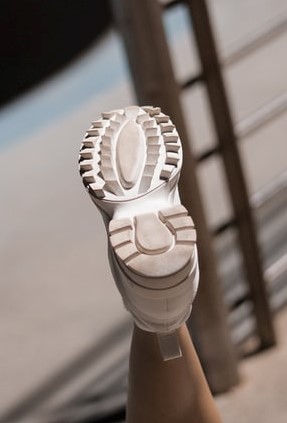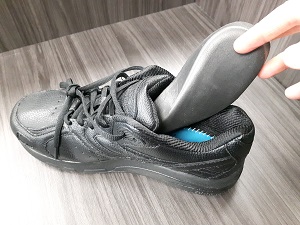
Shoe wear and your feet
The wear on your shoes can tell a lot about how your feet move. Even as Pedorthists, we typically look at your shoes for a better idea about how your feet are moving. There are cases when the shoe wear can look different than when walking barefoot. In these cases, the shoe may be affecting the way you are walking, which can be either a good or a bad thing. The typical spots to look for shoe wear is the bottom, the inside and the outside of the shoe.
Bottom of the shoe (tread)
Normal wear typically occurs slightly on the outside of the heel, and through the middle of the front of the shoe. This wear pattern follows what we consider the “normal” way of walking. When wearing your shoe on a regular basis, the tread will typically last 1-2 years, but you may start to see wear as soon as 6 months. Those with excessive wear, such as a marathon runner, may have to replace their shoes within 6 months.
Heel
The tread on the heel is typically where you can see the most wear because the hardest contact mostly occurs at the heel. Wear at the heel is considered excessive if it wears down faster than normal and/or along the entire outside of the heel border. This excessive wear might indicate that you are a supinator, which means you have a high arch and/or you put more pressure on the outside of the heel when you walk. If your heel wears down on the middle or inside of the shoe, this could indicate a flat foot and/or your heel rolls in when you walk.
Forefoot (front of the shoe)
The tread on the front of the shoe can tell you how your pushing off of the back leg when you walk. Abnormal wear is considered at the very outside of the shoe or along the inside border. Wear at the very outside may indicate a high arch or an avoidance of pain. For example, if the big toe joint is sore, pushing off of the outside of the foot will avoid this pain. If the wear occurs on the inside border of the shoe, this can indicate a flat foot or an avoidance of pain. Pushing off of the very inside of the foot can be another compensation when the big toe joint is sore.
Middle
The middle of the shoe may not show significant wear, but abnormal wear can be seen on the very outside or inside border. If there is wear on the outside border, this can indicate a high arch or an avoidance of pain. For example, if the arch is painful, walking on the outside of the foot may avoid this pain. If the shoe wears on the very inside border of the shoe, this can indicate a flat arch.
Sport Specific
What is considered abnormal for everyday shoes may be considered normal for your sport specific shoes. For example, tennis requires more aggressive side to side motions, which can develop wear on the sides of the shoes.
Inside the Shoe
Areas inside the shoe can also tell you what your feet are doing inside the shoe. After a year or two, the inside of the shoe may start to wear down. If it wears down earlier, this may be considered abnormal wear.
 Insole
Insole
The inside part of the shoe, where your foot contacts directly, typically comes out of the shoe. If insole does not come out, you may still be able to see some patterns and feel them by placing your hand inside. Look or feel for compression to the foam, discolouration and/or fabric wearing out.
The toes are typically the most visible wear spots on the insole. Wear on the big toe can indicate a flat foot. Wear on the outside toes can indicate a high arch.
The middle part of the insole may tell you information about your arch height. Wear on the very inside of the insole may indicate a severe flat foot. If there is no pressure at all in the middle of the insole, this may indicate an aggressive high arch. An aggressive high arch may also be accompanied by very high-pressure areas at the front of the foot and the heel.
If there is a sideways oval pressure area just behind the toes, this may indicate an arch collapse at the ball of the foot.
Heel
The inside of the heel can give you an indication about how your heel is moving inside the shoe. The heel should move slightly to absorb shock, but excessive motion can put stress and strain on various structures in the lower limb. An indication of excessive motion is ripped material at the heel. This can be more to the outside, inside or on both sides.
Outside of the Shoe
Shoe Tilt
If you place your shoe on a level surface, the shoe should not lean one way or the other. If there is a lean to the shoe, there may be excessive wear at a particular spot. This lean can come from a flat foot or a high arch, which wears the sole down or pushes the top of the shoe over. The side the shoe is tilting to will indicate where your foot is moving. An outside tilt can indicate a high arch and/or the heel rolling out. An inside tilt can indicate a flat arch and/or the heel rolling in.
Forefoot
If the material is ripped on the outside of the shoe, it can give you a couple indications. If the shoe is too narrow, holes may appear on the sides of the shoe over time. These holes may also develop if your feet are moving to much inside the shoe. This can be from a flat foot, very mobile joints and/or the shoe is too big.
If you would like more information, feel free to contact us!

You must be logged in to post a comment.